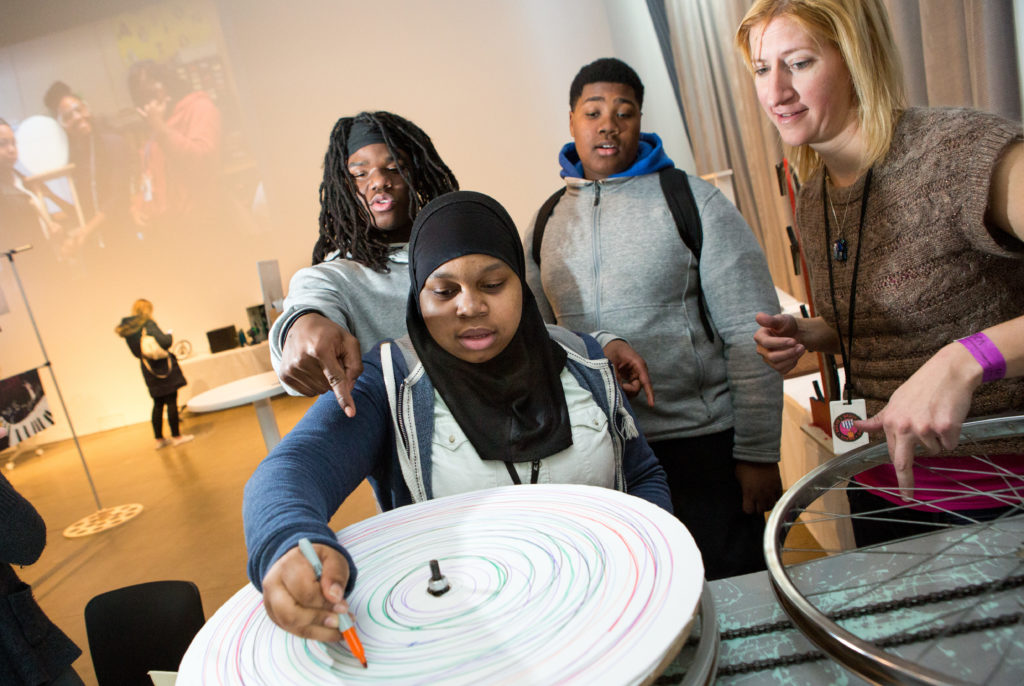AEP is Celebrating National STEM/STEAM Day!

Students try out an interactive art project during a school art show for MC2 STEM High School. Photo by Allison Shelley/The Verbatim Agency for EDUimages
Happy National STEM/STEAM Day from your friends at the Arts Education Partnership and Education Commission of the States! For those who may not be familiar, when science, technology, engineering and math include the arts as an equal partner, STEM shifts to STEAM. This summer, AEP and Education Commission of the States hosted two State Policy Academies focused on early STEM and K-12 STEAM education. There are a lot of questions about the distinctions between STEM and STEAM, and what we learned is that they are more similar than they are different. There’s value in both STEM and STEAM educators and professionals working and learning together.
Here’s how leaders from six states– Michigan, Georgia, South Carolina, Vermont, Virginia and West Virginia– responded to three key questions that we asked during the policy academies:
What does equity mean in STEM/STEAM education for students?
Building STEM and STEAM identity impacts students’ sense of belonging in STEM and STEAM careers and can play a powerful role in encouraging long-term engagement. The exclusion and underrepresentation of diverse racial and gender identities in these careers hampers the success of students who may not see themselves reflected by the scientists and artists they study. Diverse perspectives and experiences also collectively enrich the potential of STEM and STEAM fields.
Supporting STEM and STEAM identity development for students from an early age requires both state and local actions. States can design and implement policies to recruit and retain a diverse teaching workforce that reflects the populations of students served. States can also support districts in designing culturally inclusive curricula by offering equity-minded professional development to help educators ensure students see themselves reflected in their classrooms. It is especially important to center learning practices around the whole child to meet students’ social, emotional and academic needs.
What is necessary for effective STEM/STEAM instruction?
Policy academy attendees also identified supporting educators and school leaders as a key challenge that is fundamental to improving equity. Educator training and professional development focused on authentic integration of STEAM disciplines is key, particularly for elementary school educators who do not specialize in a specific subject. The type of training also matters — opportunities to spend time in critical reflection, adapting practices and building learning communities are valuable for educators, especially those teaching in small, rural districts who may be geographically disconnected from their peers.
Engaging workforce professionals from related industries also helps center authenticity in learning by demonstrating how STEM and STEAM exist in the workforce and what it means to have a STEAM career. These connections can also foster STEM and STEAM identity among students.
What opportunities do state leaders have to clarify the relationship between STEM/STEAM?
State leaders are pivotal decision makers in advancing equity in STEM and STEAM and in supporting educators and schools. The creation of advisory networks, action centers and governors’ initiatives —such as in Nevada — demonstrate how coalition building among diverse stakeholders can help articulate the connections between STEM and STEAM education. State leaders can establish frameworks to recognize schools that provide equitable access to students, such as those in Georgia and Ohio, which also provide clear guidance for schools looking to increase access to STEM and STEAM education. States can also establish diploma seals to recognize individual student achievement.
In addition to creating networks for collaboration and articulating frameworks for student and school achievement in STEM and STEAM, several states, such as Arkansas, Georgia, Kentucky, New Jersey, Ohio and South Carolina, include STEM and STEAM in their ESSER plans to support learning recovery.
In light of stagnant national achievement across various subjects, including visual arts, music, math, reading and science, STEM and STEAM education hold significant potential for raising student achievement and improving the economy. In the coming months, we will continue to watch how this work evolves across states and look forward to sharing what we learn from the six states participating in the policy academies. We will also continue to explore the complexity of how STEM and STEAM education relate to one another, considered both independently and collectively. We hope this blog post prompts you to reflect on the value of STEM and STEAM education for the students you serve. Happy STEM/STEAM Day!



